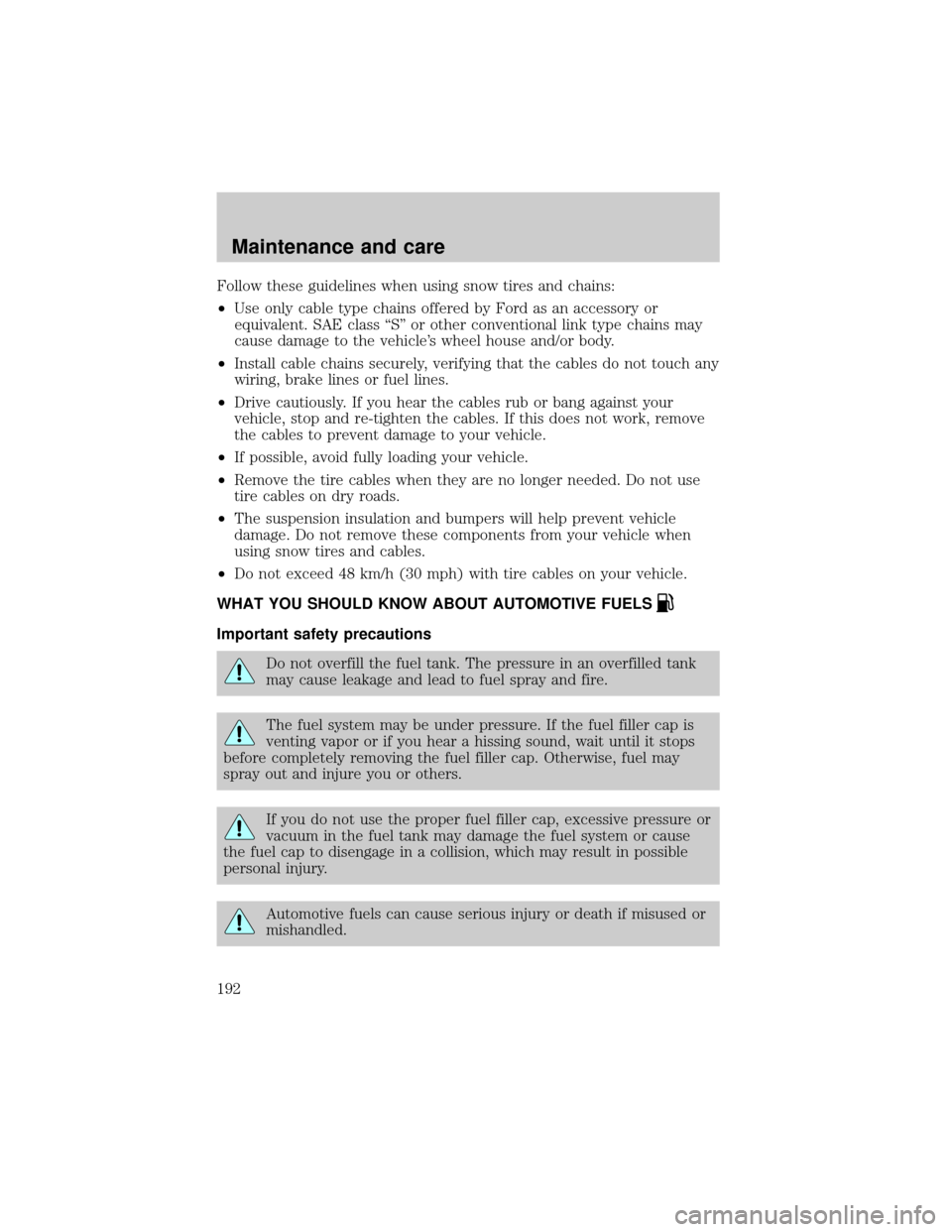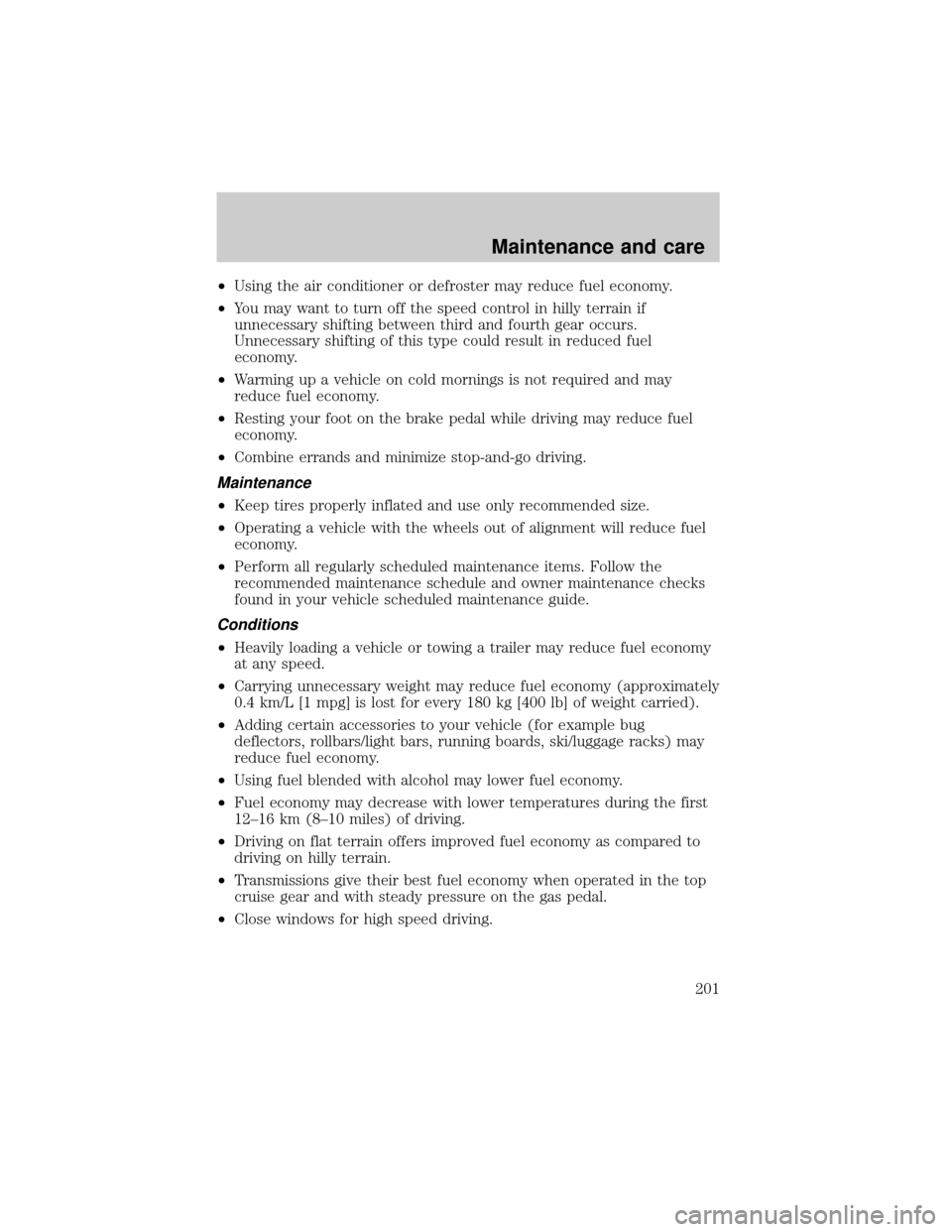Page 192 of 256

Follow these guidelines when using snow tires and chains:
²Use only cable type chains offered by Ford as an accessory or
equivalent. SAE class ªSº or other conventional link type chains may
cause damage to the vehicle's wheel house and/or body.
²Install cable chains securely, verifying that the cables do not touch any
wiring, brake lines or fuel lines.
²Drive cautiously. If you hear the cables rub or bang against your
vehicle, stop and re-tighten the cables. If this does not work, remove
the cables to prevent damage to your vehicle.
²If possible, avoid fully loading your vehicle.
²Remove the tire cables when they are no longer needed. Do not use
tire cables on dry roads.
²The suspension insulation and bumpers will help prevent vehicle
damage. Do not remove these components from your vehicle when
using snow tires and cables.
²Do not exceed 48 km/h (30 mph) with tire cables on your vehicle.
WHAT YOU SHOULD KNOW ABOUT AUTOMOTIVE FUELS
Important safety precautions
Do not overfill the fuel tank. The pressure in an overfilled tank
may cause leakage and lead to fuel spray and fire.
The fuel system may be under pressure. If the fuel filler cap is
venting vapor or if you hear a hissing sound, wait until it stops
before completely removing the fuel filler cap. Otherwise, fuel may
spray out and injure you or others.
If you do not use the proper fuel filler cap, excessive pressure or
vacuum in the fuel tank may damage the fuel system or cause
the fuel cap to disengage in a collision, which may result in possible
personal injury.
Automotive fuels can cause serious injury or death if misused or
mishandled.
Maintenance and care
192
Page 201 of 256

²Using the air conditioner or defroster may reduce fuel economy.
²You may want to turn off the speed control in hilly terrain if
unnecessary shifting between third and fourth gear occurs.
Unnecessary shifting of this type could result in reduced fuel
economy.
²Warming up a vehicle on cold mornings is not required and may
reduce fuel economy.
²Resting your foot on the brake pedal while driving may reduce fuel
economy.
²Combine errands and minimize stop-and-go driving.
Maintenance
²Keep tires properly inflated and use only recommended size.
²Operating a vehicle with the wheels out of alignment will reduce fuel
economy.
²Perform all regularly scheduled maintenance items. Follow the
recommended maintenance schedule and owner maintenance checks
found in your vehicle scheduled maintenance guide.
Conditions
²Heavily loading a vehicle or towing a trailer may reduce fuel economy
at any speed.
²Carrying unnecessary weight may reduce fuel economy (approximately
0.4 km/L [1 mpg] is lost for every 180 kg [400 lb] of weight carried).
²Adding certain accessories to your vehicle (for example bug
deflectors, rollbars/light bars, running boards, ski/luggage racks) may
reduce fuel economy.
²Using fuel blended with alcohol may lower fuel economy.
²Fuel economy may decrease with lower temperatures during the first
12±16 km (8±10 miles) of driving.
²Driving on flat terrain offers improved fuel economy as compared to
driving on hilly terrain.
²Transmissions give their best fuel economy when operated in the top
cruise gear and with steady pressure on the gas pedal.
²Close windows for high speed driving.
Maintenance and care
201
Page 248 of 256

Servicing your vehicle ..............162
Spark plugs,
specifications .....................222, 226
Specification chart,
lubricants ...........................224, 226
Speed control ..............................53
Speedometer ...............................14
Starting your vehicle ........122, 124
jump starting ..........................156
Steering wheel
tilting .........................................58
T
Tachometer .................................15
Tires ...........................152, 188±190
changing ..........................152±153
checking the pressure ............190
replacing ..................................191
rotating ....................................190
snow tires and chains ............191
tire grades ...............................189
treadwear ................................189
Towing .......................................139
recreational towing .................142
trailer towing ..........................139
wrecker ....................................161
Traction control ..................52, 130
active light ..................................8
Transaxle
automatic operation ...............132
fluid, refill capacities ..............223
lubricant specifications ..........226
Transmission
fluid, checking and adding
(automatic) .............................178lubricant specifications ..........224
Trip odometer .............................16
Trunk .........................67, 69, 71, 83
remote release ..........................66
Turn signal ..............................8, 56
V
Vehicle dimensions ...................226
Vehicle Identification Number
(VIN) ..........................................229
Vehicle loading ..........................137
Ventilating your vehicle ...........126
W
Warning chimes .....................13±14
Warning lights (see Lights) .........8
Washer fluid ..............................170
Water, Driving through .............138
Windows
power .........................................62
rear wiper/washer .....................57
Windshield washer fluid and
wipers
checking and adding fluid .....170
checking and cleaning ....187±188
liftgate reservoir .....................171
operation ...................................56
replacing wiper blades ...........188
Wrecker towing .........................161
Index
248